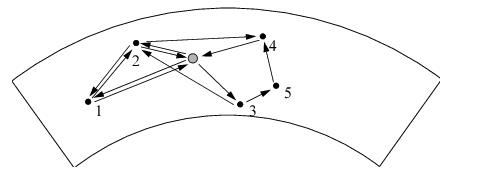4.3 Position Mode Observing Strategies
Measurement errors can be minimized by carefully structuring the order of exposures in a visit. This section describes strategies which maximize science return.
4.3.1 Summary of Position Mode Error Sources
The reduction of a Position mode data set requires several corrections and calibrations:
Exposure Level:
- Background determination.
-Star Selector encoder positions (7 LSB).
-PMT response.
-Optical Field Angle Distortion calibration.
-Differential velocity aberration.
-Lateral color aberration.
Visit Level
-Vehicle jitter.
-Drift of FGS’s FOV.
-Cross filter (F583W v. F5ND, if used).
Program Level
-Plate solutions (4 or 6 parameter fits).
-Plate scale.
Each of the corrections and calibrations are briefly discussed in Chapter 5, and are thoroughly reviewed in the FGS Data Handbook. Many of the corrections specified on the list are determined by analysis of individual observations and removed later in the data reduction processing, (e.g., jitter data is retrieved from the guide star telemetry and removed from the target data). Calibrations, such as the plate scale, the OFAD, lateral color, and cross filter effect are derived from STScI calibration programs. A potentially dominant source of error, the FOV drift (time scale of several minutes), must be measured during the visit, and to that end, the sequence of exposures must be carefully arranged.
4.3.2 Drift and Exposure Sequencing
Stars observed more than once per visit (“check stars”) are typically seen to drift across the FGS by ~ 2 to 6 mas when two FGSs guide the telescope (or ~ 5 to 20 mas with only one FGS guiding). Because astrometry observations execute sequentially, the errors in the measured angular separations between objects increase as the time between the measurements lengthens. If uncorrected, this drift will overwhelm the astrometry error budget.
Whatever causes the position of an object to “drift” in the astrometer’s FOV affects the guiding FGSs as well. The apparent motion of the guide stars are interpreted as “errors” by the pointing control system and are “corrected” by a small vehicle maneuver. The astrometry FGS witnesses the pointing change. Therefore, the check star motion will have a contribution from all three FGSs.
When only one FGS is used for guiding, the telescope is not roll-constrained, and large motions in the astrometric FGS - up to 10 mas - are not uncommon. Nevertheless, this drift can be successfully removed from the astrometry data, provided the proposal specifies an adequate check star sequence. The more check star observations, the more precise the drift correction. Check stars can be reference or science targets. Ideally, both rotation and translation corrections should be applied to the data, implying the use of at least two check stars with at least three measurements each.
The need to observe check stars can be in conflict with other aspects defining an optimal observing strategy, so compromises will be necessary. Overall an optimal Position mode visit is scripted to:
- Define a check star strategy which will be robust against FOV drift.
- Maximize the number of reference stars observed.
- Maximize the number of observations of each object.
For example, a visit could contain 10–35 exposures, provided the overheads are minimized and exposure times are less than 20 seconds. A sample geometry is given in Figure 4.2, where the science target is represented by the central object.
1 - 2 - target - 3 - 2 - 4 - target - 3 - 5 - 4 - target -->--> 2 - 1 - target - 3 - 5 - 4 - target - 2 - 1 - target.4.3.3 Cross Filter Observations
Targets brighter than V = 8 cannot be observed with the F583W. The F5ND attenuator must be used for such observations. If the visit includes observations of fainter objects with the F583W, a cross-filter correction will be needed for the data reduction. For FGS3, the F583W/F5ND cross-filter effect was found to be astrometrically large (~ 7 mas) and varied with location in the FOV. This effect as been calibrated at the center of FGS1r’s FOV by STScI calibration programs. If needed at other locations in the FOV, special calibrations by the proposer might be required.
4.3.4 Moving Target Observation Strategy
In Position mode, the FGS can track a bright target (V<14.0) whose motion is less than ~ 0.1 arcsec per second. However, planning the observation requires extreme precision: the moving target must be accurately located, to within 10 arcsec, in the IFOV at the start of the exposure, implying a very accurate ephemeris. Transfer mode observations of moving targets are discussed in the next section.
